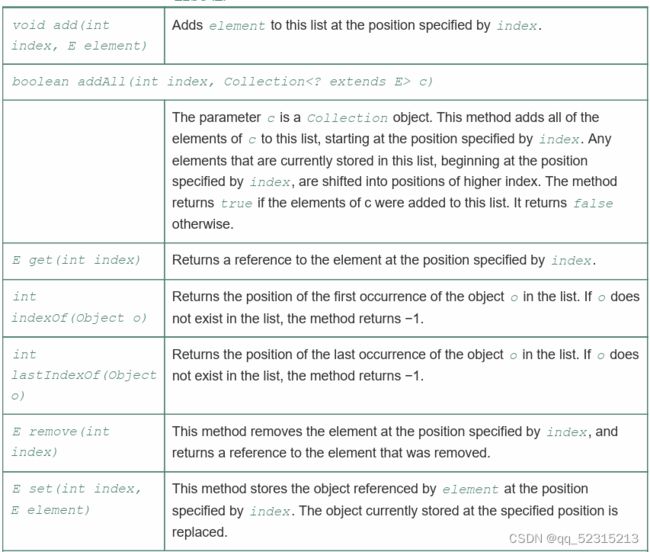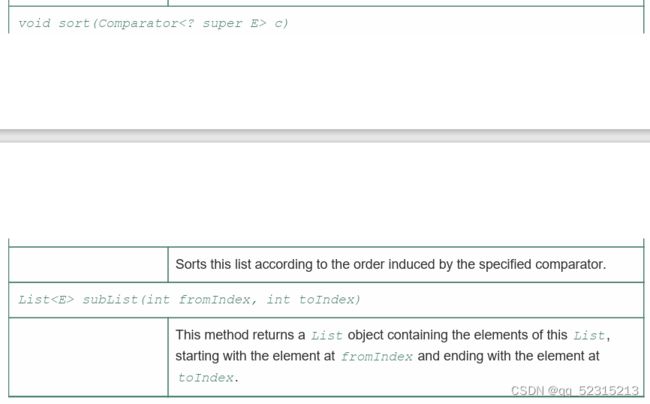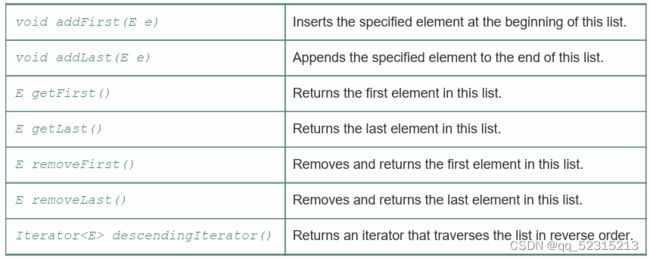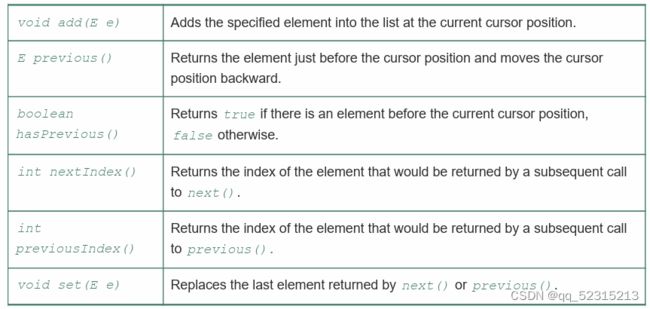学习笔记21 list
一、概述
有两种不同的方法来实现List接口。ArrayList类使用基于连续内存分配的实现,而LinkedList实现基于linked allocation。
list接口提供了一些方法:
二、The ArrayList and LinkedList Classes
1.构造方法
这两个类有相似的构造方法:
ArrayList()
ArrayList(int initialCapacity)
ArrayList(Collection c)LinkedList()
LinkedList(Collection c)使用第三种构造方法可以将list转为arraylist:
import java.util.ArrayList;
import java.util.Arrays;
import java.util.List;
public class ArrayListDemo {
public static void main(String[] args) {
// 创建一个包含一些整数的列表
List numbers = Arrays.asList(1, 2, 3, 4, 5);
// 使用 ArrayList(Collection c) 构造方法创建一个新的 ArrayList 对象
ArrayList arrayList = new ArrayList<>(numbers);
// 打印 ArrayList 的内容
System.out.println(arrayList);
}
} 用for循环将数组转为linkedlist:
// Initialize array of names.
String [] namesArray = {"Anna", "Bob", "Carlos", "Debby"};
// Create empty list.
LinkedList list1 = new LinkedList<>();
// Populate the list using a loop.
for (String s : namesArray)
{
list1.add(s);
}
System.out.println(list1); 注意,java中的collection都自带toString方法,结果如下:
[Anna, Bob, Carlos, Debby]
2.asList
我们可以不用for循环遍历,而直接把一个array转化为linkedlist或arraylist:
// Initialize array of names.
String[] namesArray = {"Anna", "Bob", "Carlos", "Debby"};
// Create LinkedList from array using constructor.
LinkedList linkedList = new LinkedList<>(Arrays.asList(namesArray)); 也可以这样:
LinkedList list2 =
new LinkedList<>(Arrays.asList("Anna", "Bob", "Carlos", "Debby"));3.linkedlist中的其他方法
三、List Iterators
迭代器可以在列表中向前或向后移动。除了 next() 方法外,列表迭代器还有一个 previous() 方法,列表迭代器有一个光标位置,它总是位于调用 previous() 方法返回的元素和调用 next() 方法返回的元素之间。
最初,光标位于索引为 0 的元素之前。调用 next() 时,光标将返回索引为 0 的元素,并越过返回的元素向前移动到元素 0 和元素 1 之间的位置。此时,调用 previous() 将返回元素 0,并将光标移回起点,但调用 next() 将返回元素 1,并将光标向前移动到元素 1 和元素 2 之间的位置。如果光标已经越过最后一个元素,调用 next() 将抛出 NoSuchElementException 异常。同样,如果光标位置在元素 0 之前,调用 previous() 也会产生同样的异常。
列表迭代器中的 remove() 方法会从列表中删除最后一次调用 next() 或 previous() 时返回的元素。
也就是说,如果在调用 `remove()` 方法之前没有先调用 `next()` 或 `previous()` 方法,那么会抛出一个 `IllegalStateException` 异常。
这是因为 `remove()` 方法的作用是删除迭代器最后访问的元素,所以在调用 `remove()` 方法之前必须先调用 `next()` 或 `previous()` 方法,以确保迭代器已经指向了要删除的元素。
如果在调用 `remove()` 方法之前没有先调用 `next()` 或 `previous()` 方法,那么迭代器没有指向任何元素,也就无法删除元素,因此会抛出 `IllegalStateException` 异常。
这里的迭代器的remove方法和list的remove方法不是一个东西,自然不能按原来的方式理解。
list的迭代器还提供了以下方法:
例子:
import java.util.*;
/**
* Demonstrates the list iterator
*/
public class ListIteratorDemo {
public static void main(String[] args) {
// Create an array list to hold strings.
String[] names = {"Chris", "David", "Katherine", "Kenny"};
List nameList = new ArrayList<>(Arrays.asList(names));
// Display the names in the list.
System.out.println("Here are the original names.");
System.out.println(nameList);
// Get a list iterator.
ListIterator it = nameList.listIterator();
// Add "Darlene" to the list right after "Chris".
while (it.hasNext()) {
String str = it.next();
// If the last name retrieved was "Chris"
// then insert "Darlene".
if (str.equalsIgnoreCase("Chris")) {
it.add("Darlene");
// We are done
break;
}
}
//Display the names in the list again.
System.out.println("\nHere are the new names now.");
System.out.println(nameList);
}
} Here are the original names.
[Chris, David, Katherine, Kenny]
Here are the new names now.
[Chris, Darlene, David, Katherine, Kenny]
四、用list接口变量去引用linkedlist或arraylist
推荐使用
List nameList = new ArrayList<>(); 而不是
ArrayList nameList = new ArrayList<>(); 因为第一种方法后期容易修改。
比如在后期发现namelist实际上应该使用linkedlist,这是只需要把第一句改成:
List myList = new LinkedList<>(); 这时,项目中所有的myList就都变成了Linkedlist。
如果用第二种方法,我们在项目中别的地方传参的时候,会传入(arraylist nameList),这时如果要换成Linkedlist,我们需要改变所有传入参数的类型。
使用第一种方法,我们传的参数是(List nameList),就不需改变。



